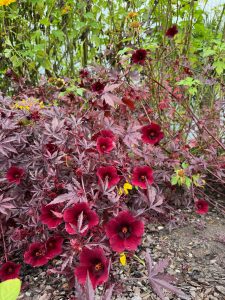There’s a strong case to be made that spring and early summer are the most exciting times in the garden. Still, with some strategic planning, you can achieve a lively and vibrant landscape throughout the year by adding key perennials and trees. Here are a few of my favorite Florida-Friendly plants that provide beautiful colors in late autumn.
Cranberry hibiscus- Hibiscus acetosella
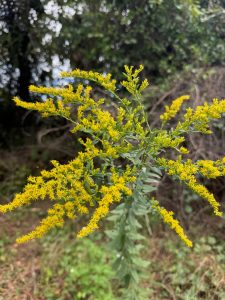
Goldenrod- Solidago spp.
Often dismissed as simply a weed, this showy native plant is one of Florida’s important keystone plants. It is easily cultivated in home landscapes and pollinator gardens.
There are 22 Solidago species found in Florida. All 22 are considered native and support a variety of wildlife from bees to beetles and birds. Goldenrods host an astounding 82 caterpillars and support four types of native bees that prefer the pollen of goldenrod to other flowers! A member of the aster family, goldenrod blooms in late summer through fall. Of the four native species most commonly grown commercially, Solidago odora var. chapmanii, or Chapman’s goldenrod, is one of the best suited to home landscapes as it is highly adaptable.
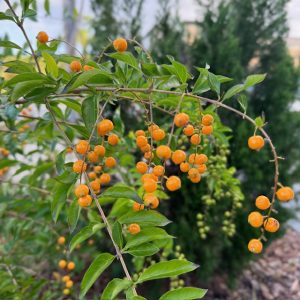
Golden Dewdrop- Duranta erecta
Known for its vibrant purple blooms that grace the spring and summer seasons, this fast-growing shrub also makes a statement in the fall. During this time, duranta showcases beautiful drooping clusters of golden yellow berries that ripen from late summer to autumn. While these berries are a favorite treat for songbirds, they are toxic to humans and pets. The origins of this evergreen shrub or small tree are debated. Some sources indicate it is native to the West Indies and Central America, while others point to the Florida Keys Even if it’s not officially recognized as a Florida native, golden dewdrop is not considered invasive and is a popular choice for Florida-Friendly gardens.

Bald Cypress- Taxodium distichum
Cypress are deciduous conifers that put on a stunning display of fall color before their needles drop. These beauties can be found in the entire southeastern United States, from east Texas up into Atlantic costal states as far north as Delaware. In Florida, though, their remarkable show of warm autumnal color isn’t overshadowed by other traditional deciduous trees like it can be in the northern parts of their range.
Although native to wetlands along running streams, bald cypress growth is often faster on moist, well-drained soil. Plant these easy going trees on the banks of a retention pond, creekside, or even in drier areas of the urban landscape. They have adapted to withstand full sun to partial shade and semi aquatic to dry soils. When considering placement one thing to think about is the development of “knees”, or root projections, that will extend above the soil surface. These can be trip hazards and cause mowing challenges. Remarkably, the roots do not seem to push up sidewalks and curbs as much as some other species do.

Pink Muhly Grass- Muhlenbergia capillaris
Nothing compares to the delicate mauve inflorescences of pink muhly blowing softly in a warm autumn breeze. Muhly grass is a true spectacle during this season, enchanting landscapes with feathery seed heads that appear to sparkle in the rays of the sun. Muhly grass is a staple in the nursery market. It is frequently chosen for commercial landscapes, primarily due to its resilience to drought and the little care it demands. Use this bunch grass en masse or singly as an accent plant. Either way this native beauty offers structure to the landscape while providing much needed habitat for small critters.
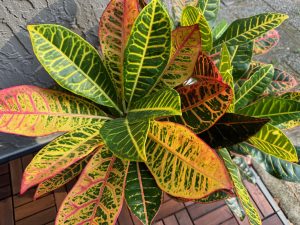
Croton-Codiaeum variegatum
Instead of opting for short-lived mums and other annuals as seasonal decor, why not try a croton? These ornamental foliage plants are equally as easy to grow in the ground as they are in pots. Place them in planters by your front door for festive color now, and then plant them in the garden later on for low maintenance year-round color and a tropical look.
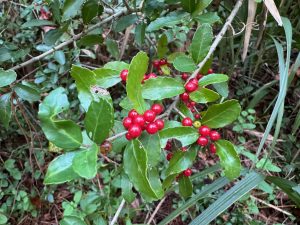
Holly- Ilex spp.
Hollies are simple, reliable, low-maintenance plants that reserve a colorful surprise for the waning months of the year. Diverse sizes, forms, and textures exist, ranging from large trees to dwarf shrubs. There are three common hollies native to Florida: American, yaupon, and dahoon, as well as a hybrid of American and dahoon called ‘East Palatka’ holly. All four produce vibrant red fruits that birds and small mammals eat. A real eye catcher, even from a distance the bright red berries that ripen in autumn stand out starkly against the shiny evergreen leaves.
Holly trees are dioecious, meaning there are both male and female plants. Purchase specimens with berries on them (females) or buy trees which were propagated from cuttings of female plants to ensure you get berry producers. Bees are the primary pollinators of holly flowers and will carry pollen from male plants as far away as 2 miles! That said, it is not necessary to have a male holly in the immediate area to ensure fruiting.
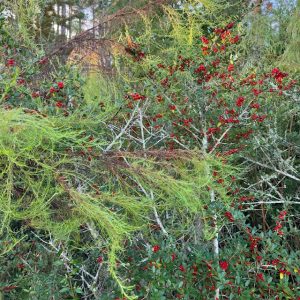
By embracing a few of these Florida-Friendly plants you can keep your landscape colorful and interesting all fall. Not only will it be pleasing to the eye, the wildlife will thank you, too! To search for more Florida-Friendly plants download the FREE Florida-Friendly Landscaping plant guide. You can filter and sort results by a number of different factors such as sun/shade conditions, pH preference, salt tolerance, native status, bloom color, and more! It’s so easy to use and really takes the guesswork out of finding suitable plants for any landscape. Happy fall y’all!
 8
8
